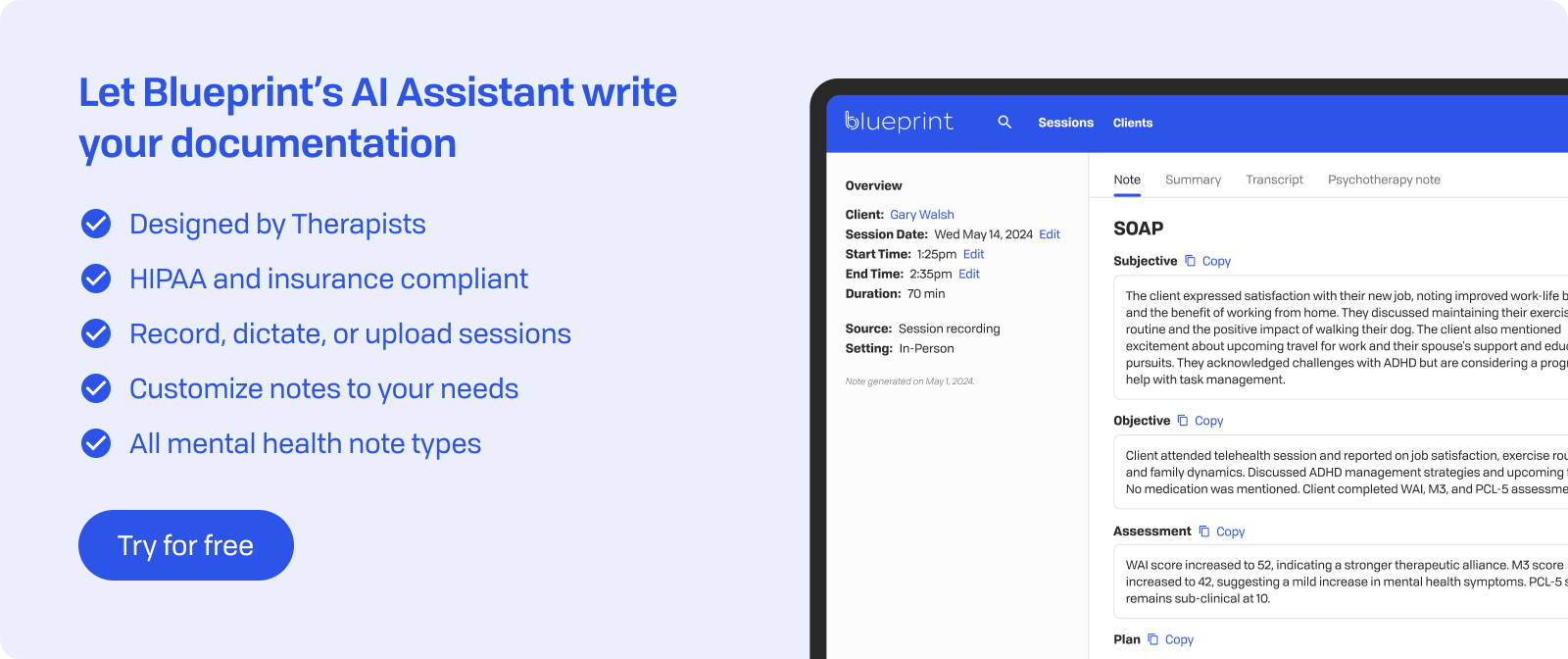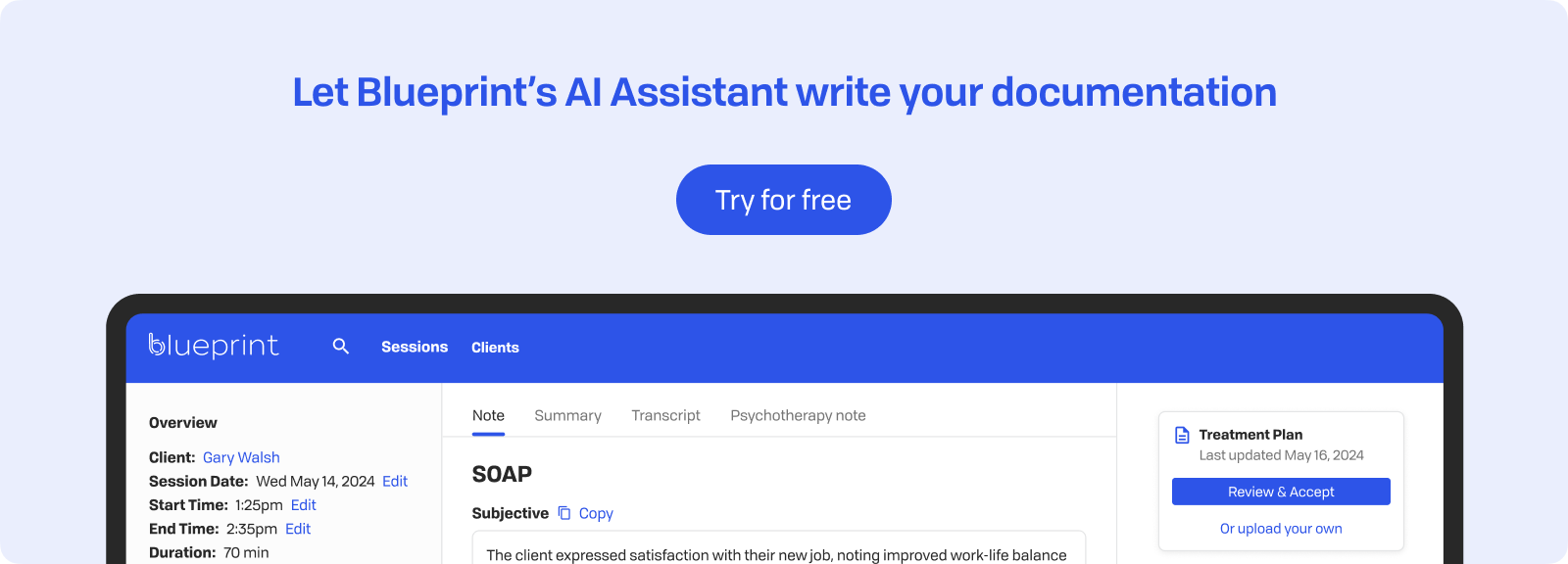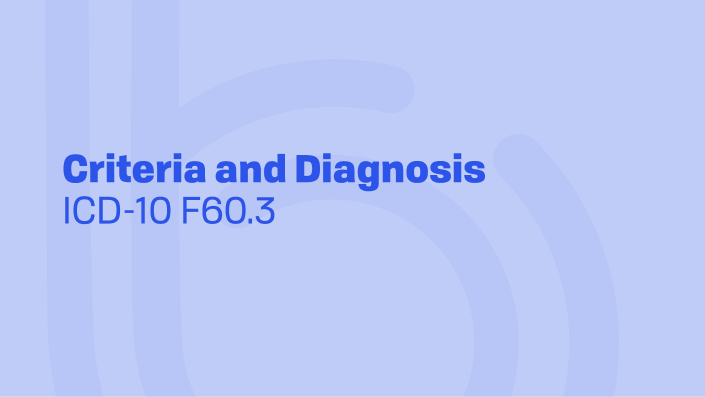In Brief
Borderline Personality Disorder (BPD), coded as F60.3 in ICD-10, remains one of the most complex and often misunderstood diagnoses in clinical practice. While the DSM-5-TR provides clear criteria for identifying BPD, many U.S. clinicians approach this diagnosis with caution.
Stigma—both within the broader culture and, at times, within the mental health field itself—can lead to hesitancy in naming the condition, even when criteria are met. Some therapists worry about the potential impact of the label on clients’ self-concept, treatment engagement, or how they are perceived within healthcare systems. At the same time, others may be too quick to assign this diagnosis, sometimes relying on the client’s presentation over one or two interactions when the client is under duress instead of looking at long-term patterns. Other times, overlooking differential diagnoses or the role of trauma and environmental stressors in shaping symptoms.
This tension underscores the need for careful, nuanced assessment that balances diagnostic precision with therapeutic sensitivity.
Diagnostic Criteria and Clinical Features of Borderline Personality Disorder
For U.S.-based clinicians, diagnosing Borderline Personality Disorder (BPD) requires applying the DSM-5-TR criteria while using the ICD-10 code F60.3 for billing and insurance purposes. This dual approach ensures both clinical accuracy and compliance with documentation standards.
According to the DSM-5-TR, BPD is characterized by a pervasive pattern of instability in interpersonal relationships, self-image, and emotions, as well as marked impulsivity, beginning by early adulthood and present across a variety of contexts. Additionally, a BPD diagnosis requires that at least five of the following nine criteria be met:
- Frantic efforts to avoid real or imagined abandonment
- A pattern of unstable and intense interpersonal relationships, alternating between extremes of idealization and devaluation
- Identity disturbance, such as markedly unstable self-image or sense of self
- Impulsivity in at least two areas that are potentially self-damaging (e.g., spending, sex, substance use, reckless driving, binge eating)
- Recurrent suicidal behavior, gestures, threats, or self-mutilating behavior
- Affective instability due to marked reactivity of mood (e.g., intense episodic dysphoria, irritability, or anxiety)
- Chronic feelings of emptiness
- Inappropriate, intense anger or difficulty controlling anger
- Transient, stress-related paranoid ideation or severe dissociative symptoms
Clinically, BPD often presents as emotional dysregulation, difficulty tolerating distress, and struggles with self-concept and relationships that are often rooted in fear of abandonment. Many clients with BPD experience rapid mood shifts and difficulty maintaining stable connections. These symptoms may lead to crises that bring clients into care, including self-harm or suicidal behaviors.
Accurate diagnosis requires careful assessment of the frequency, intensity, and pervasiveness of these features, as well as differentiation from other personality disorders, mood disorders, and trauma-related conditions. Documenting not only the criteria met but also relevant contextual factors—such as trauma history, environmental stressors, and cultural considerations—helps ensure both diagnostic precision and therapeutic sensitivity.

Accurate Documentation and Coding
Clear, specific documentation forms the backbone of accurate F60.3 coding and can have a direct impact on treatment authorization and reimbursement. Your clinical notes should describe details of the client's behavior rather than relying on subjective or vague interpretations. For example, instead of writing "client was upset," document "client exhibited pressured speech, clenched fists, and reported feeling 'like I'm going to explode' when discussing relationship conflicts."
To ensure correct use of F60.3 and minimize insurance disputes, follow these important practices:
- Document specific diagnostic criteria met: List which ICD-10 criteria the client fulfills, using direct quotes and observable behaviors that support each criterion.
- Include functional impairment details: Describe how symptoms affect work, relationships, and daily activities with concrete examples.
- Note symptom duration and frequency: Specify timeframes like "reported daily mood swings lasting 2-4 hours over the past 8 months."
- Justify medical necessity: Connect symptoms to treatment goals and explain why specific interventions are clinically appropriate.
- Update documentation regularly: Reflect symptom changes, treatment response, and evolving clinical presentation.
Common coding errors that can lead to claim denials include:
- Using unspecified personality disorder codes: F60.9 when clear borderline features are present.
- Failing to document comorbidities: Not including additional diagnoses that often accompany F60.3, such as post-traumatic stress disorder and depressive disorders.
- Inadequate clinical justification: Vague descriptions that don't support the severity of diagnosis.
Insurance reviewers need to understand the clinical rationale from your documentation alone. Each note should stand independently as evidence supporting the F60.3 diagnosis and the necessity for ongoing treatment.
Clinical Presentation and Comorbidities
Borderline Personality Disorder usually starts to appear during adolescence or early adulthood, with symptoms often noticeable between the ages of 18–25, though they may emerge earlier in some cases. Because teen personalities are still forming, some clinicians hesitate to make this diagnosis before age 18. However, when a younger adolescent clearly meets all DSM-5-TR criteria, assigning the diagnosis is considered appropriate and can be clinically beneficial. Early recognition allows access to evidence-based interventions—such as DBT or mentalization-based therapy—that may reduce risk and improve long-term outcomes.
Long-term studies show that BPD is less stable than once thought. A 10-year prospective study found that 50% of patients achieved recovery, defined as both symptomatic remission and good functioning, while 93% achieved symptomatic remission lasting two years and 86% for four years. Though about one-third later lost their recovery or remission status, the overall course is more hopeful than previously believed.
Functional impairment, particularly in relationships, often persists even as symptoms improve. Compared to other mental disorders, individuals with BPD show poorer social functioning. Functioning tends to fluctuate alongside symptom severity, reflecting the “stable instability” of the disorder.
Accurate diagnosis requires careful assessment of the frequency, intensity, and pervasiveness of symptoms, with attention to differential diagnoses such as bipolar disorder, PTSD, complex PTSD, and substance use disorders. Documenting trauma history, developmental stage, and medical rule-outs supports both precise ICD-10 coding and therapeutic sensitivity.
In addition to ruling out differential diagnoses, clinicians should be mindful of the high rates of comorbidity in BPD, as co-occurring conditions can complicate both assessment and treatment planning. The complexity of diagnosing F60.3 BPD increases due to high rates of co-occurring conditions.
Common Comorbid Conditions in BPD
- Depressive disorders: Among the most frequent comorbidities; recurrent major depressive episodes are common and may intensify feelings of emptiness or hopelessness.
- Anxiety disorders: Panic disorder, generalized anxiety disorder, and social anxiety disorder are frequently reported and may compound avoidance behaviors and functional impairment.
- Posttraumatic stress disorder (PTSD) and complex PTSD: Trauma histories are highly prevalent; overlapping symptoms such as hyperarousal, dissociation, and affective instability are common.
- Substance use disorders: Substances are often used to self-medicate emotional distress; research suggests men with BPD are at particularly high risk.
- Eating disorders: Bulimia nervosa and binge eating disorder occur more commonly in women with BPD, often linked to impulsivity and emotion regulation challenges.
- Attention-Deficit/Hyperactivity Disorder (ADHD): Increasingly recognized as a co-occurring condition, particularly when impulsivity and emotional dysregulation are prominent; careful assessment is needed to distinguish overlapping symptoms.
- Other personality disorders: While it is possible for individuals with BPD to meet criteria for another personality disorder (such as Antisocial, Narcissistic, or Histrionic PD), clinicians should weigh whether additional diagnoses add clarity to the clinical formulation or risk compounding stigma without improving treatment planning.
Recognizing and documenting these comorbidities supports accurate clinical formulation, informs treatment priorities, and ensures compliance with ICD-10 coding standards.

Treatment Planning Through the ICD-10 Lens
For U.S. clinicians, treatment planning for Borderline Personality Disorder (BPD; ICD-10 code F60.3) requires balancing accurate coding, clinical best practices, and therapeutic sensitivity. While ICD-10 provides the billing framework for code F60.3, the DSM-5-TR criteria remain the clinical anchor for guiding interventions and documenting medical necessity.
Effective treatment planning begins with a clear formulation that captures the client’s symptom presentation, functional impairments, and comorbid conditions. Documentation should explicitly link symptoms that meet DSM-5-TR criteria with their impact on daily functioning, as this not only supports ICD-10 coding but also strengthens the rationale for chosen interventions.
Evidence-based interventions for BPD include:
- Dialectical Behavior Therapy (DBT): The most widely researched treatment for BPD, focusing on skill-building in the areas of emotion regulation, distress tolerance, interpersonal effectiveness, and mindfulness.
- Mentalization-Based Therapy (MBT): Helps clients improve capacity to understand their own and others’ mental states, reducing interpersonal conflict and emotional reactivity.
- Transference-Focused Psychotherapy (TFP): A psychodynamic approach aimed at integrating fragmented self-perceptions through exploration of the therapeutic relationship.
- Schema Therapy: Targets maladaptive beliefs and coping styles that underlie emotional and relational instability.
- Pharmacotherapy (adjunctive): While no medication specifically treats BPD, selective use may help manage co-occurring mood, anxiety, or impulsivity symptoms.
Risk management is a critical part of treatment planning. Given the elevated risk profile associated with the F60.3 BPD diagnosis, ongoing risk assessment and documentation are essential. Meta-analytic findings indicate that 2–5% of individuals with BPD die by suicide, with more than 75% reporting at least one suicide attempt. Mortality from suicide among people with BPD is significantly higher than in other personality disorders (5.9% vs. 1.4%). These statistics highlight the importance of routinely evaluating suicidal ideation, self-harm behaviors, and other risk factors, while also documenting protective factors and collaborative safety planning.
Finally, treatment planning should account for the longitudinal course of BPD. Research shows that while many individuals achieve symptomatic remission, functional challenges—particularly in relationships and vocational stability—may persist. Documenting both progress and ongoing areas of impairment provides a clear record for continuity of care, insurance review, and collaboration with multidisciplinary providers.
Evidence-Based Therapeutic Approaches
Several widely recognized treatments have shown effectiveness for F60.3, each with distinct theoretical foundations and clinical applications. Knowing their differences helps match clients to the most suitable intervention based on their presentation, readiness, and treatment goals.
Dialectical Behavior Therapy (DBT) is the most extensively researched treatment, with a high number of randomized controlled trials supporting its efficacy. The standard program runs 12-24 months and combines weekly individual therapy, skills groups, phone coaching, and therapist consultation teams. DBT's structured approach works well for clients with high-risk behaviors and severe emotional dysregulation.
Schema Therapy takes a longer-term approach, typically spanning 2-3 years, focusing on identifying and modifying deeply ingrained maladaptive schemas from childhood. Research shows comparable effectiveness to DBT, with some studies suggesting better outcomes for emotional dysregulation. The intensive therapeutic relationship provides a corrective emotional experience.
Transference-Focused Psychotherapy (TFP) uses psychodynamic principles over 2-3 years of twice-weekly sessions. Evidence supports its effectiveness in improving interpersonal functioning and reducing self-harm, though it requires specialized training and might be less accessible than DBT.
Mentalization-Based Treatment (MBT) typically runs 12-18 months and aims to improve the capacity to understand mental states in oneself and others. Research shows effectiveness comparable to other specialized treatments, with particular strength in improving interpersonal relationships.
When choosing treatment modalities, consider:
- Symptom severity: DBT for high-risk behaviors; Schema Therapy for chronic patterns
- Client preferences: Skills-based vs. exploratory approaches
- Resource availability: DBT's group component vs. individual-only modalities
- Therapist expertise: Specialized training requirements vary significantly

Integrating Trauma-Focused Interventions
Borderline Personality Disorder (ICD-10: F60.3) often develops in the context of severe and chronic childhood trauma, including experiences of abuse, neglect, and attachment disruption. While the treatments described above provide effective frameworks for building stability and improving functioning, many clients eventually benefit from trauma-focused modalities once a foundation of safety and emotional regulation has been established.
Approaches such as Eye Movement Desensitization and Reprocessing (EMDR), trauma-focused cognitive-behavioral therapies, and other evidence-based trauma interventions can be highly effective for addressing the unresolved traumatic experiences that frequently underlie symptoms of F60.3. These modalities are typically introduced after stabilization has been achieved—when clients are no longer engaging in frequent self-harm, have built basic distress tolerance skills, and can maintain therapeutic safety.
When incorporating trauma-focused work into a treatment plan for F60.3, ensure documentation reflects the client’s readiness (e.g., consistent use of DBT skills, reduced crisis behaviors), the rationale for integrating a trauma modality, and the specific trauma symptoms being targeted. This supports both clinical clarity and compliance with ICD-10 coding while helping to prevent retraumatization.
By sequencing treatment—first stabilization through structured interventions like DBT or MBT, followed by targeted trauma processing—clinicians treating F60.3 can address both the presenting symptoms and the root causes, supporting lasting recovery and improved quality of life.
Clinical Strategies and Tools for Practice
Working with F60.3 involves specific tools that help track symptoms, maintain safety, and support therapeutic progress. These practical strategies improve treatment effectiveness while providing structure for both you and your clients.
Key Clinical Tools:
- Diary Cards: Daily tracking sheets where clients record emotions, urges, behaviors, and skill use. These provide real-time data about symptom patterns and help identify triggers between sessions.
- Chain Analysis: A detailed examination of events leading to problem behaviors. This tool breaks down the sequence of thoughts, feelings, and actions, revealing intervention points for future situations.
- Safety Planning: Collaborative crisis management documents listing warning signs, coping strategies, support contacts, and professional resources. Update these regularly as clients develop new skills.
The therapeutic relationship in F60.3 work requires careful attention to consistency, validation, and clear communication. Clients often test boundaries due to abandonment fears, making predictable responses important. Validate their emotional experience while maintaining therapeutic limits, and address ruptures directly when they occur.
Crisis Management Strategies:
- Set clear after-hours boundaries while ensuring clients know how to access emergency resources
- Develop specific protocols for self-harm urges that balance support with client responsibility
- Use brief check-ins rather than extended crisis sessions to avoid reinforcing maladaptive patterns
Long-term progress tracking involves regular assessment using validated measures like the Borderline Symptom List-23 (BSL-23) or Borderline Evaluation of Severity Over Time (BEST). These tools quantify improvement areas that might otherwise go unnoticed, providing objective evidence of change when clients feel stuck. Document specific behavioral changes monthly, noting frequency and intensity shifts in target symptoms.

Key Takeaways
Working with F60.3 requires both clinical accuracy and therapeutic adaptability. Addressing the complexity of Borderline Personality Disorder means maintaining diagnostic precision while adjusting your approach to fit each client’s unique presentation and needs.
Accurate ICD-10 coding serves multiple important functions beyond administrative needs:
- Supports medical necessity by clearly linking DSM-5-TR criteria to the client’s functional impairments.
- Guides treatment planning, ensuring that interventions are targeted to the specific symptom profile and comorbid conditions.
- Facilitates continuity of care across providers and systems, especially important given the long-term and often fluctuating course of BPD.
- Reduces stigma when paired with sensitive documentation that highlights strengths, progress, and contextual factors rather than labeling alone.
- Protects reimbursement compliance, helping to justify the level of care needed for clients with high clinical complexity.
Ultimately, clinicians treating F60.3 are tasked with combining diagnostic precision, trauma-informed care, and flexibility in intervention to best support clients in achieving both symptomatic relief and improved functioning. Encouragingly, long-term studies show that the majority of individuals with BPD achieve significant remission over time—reminding clinicians and clients alike that recovery is not only possible but probable with sustained, evidence-based care.

How Blueprint can help streamline your workflow
Blueprint is a HIPAA-compliant AI Assistant built with therapists, for the way therapists work. Trusted by over 50,000 clinicians, Blueprint automates progress notes, drafts smart treatment plans, and surfaces actionable insights before, during, and after every client session. That means saving about 5-10 hours each week — so you have more time to focus on what matters most to you.
Try your first five sessions of Blueprint for free. No credit card required, with a 60-day money-back guarantee.
























